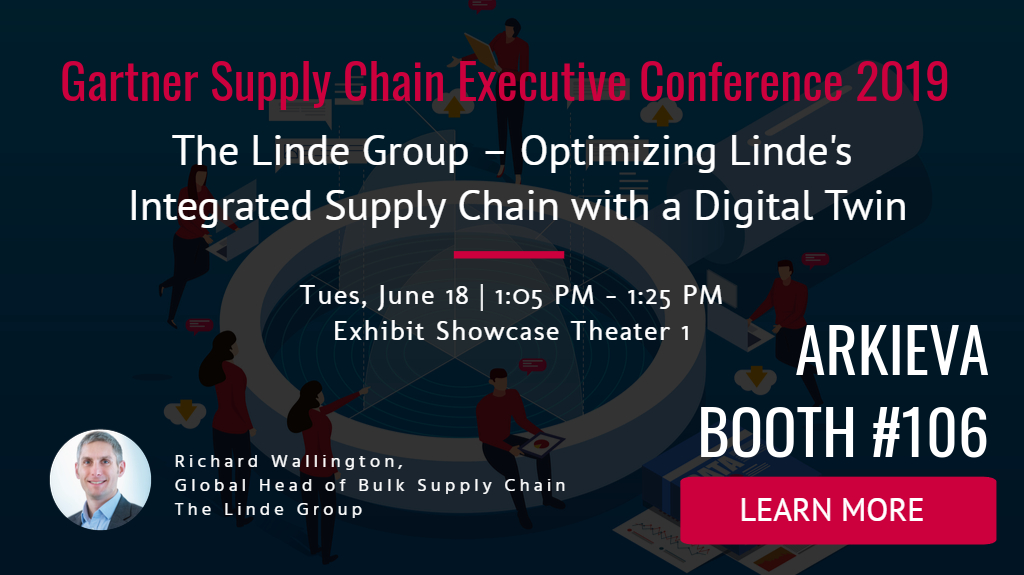Arkieva Customer, Linde PLC, is a leading supplier of industrial gases in the world. Linde has transformed its network optimization processes by creating a digital twin of its integrated supply chain with Arkieva. I sat down with Richard Wallington, Global Head of Bulk Supply Chain at Linde to find out more.
Going the 2019 Gartner Supply Chain Executive Conference in Barcelona, Spain? Attend Richard’s talk on applying the digital supply chain twin concept and meet Richard in person at the Arkieva booth #106.
Who is Linde?
Q: First, before we get into the fun supply chain optimization questions, can you tell us what Linde does and what your role is at Linde?
A: Linde produces industrial, medical and specialty gases for numerous industries. Our products are supplied via pipelines to tonnage customers, in liquid form to Bulk customers and compressed into cylinders for Packaged Gas customers. Linde’s products touch every industry and everyone’s life. I work in Linde’s Centre of Excellence and have responsibility for the end-to-end Bulk Supply Chain processes. My role is to encourage best practices across Linde’s operating businesses and implement new processes to drive productivity.
What is a Digital Supply Chain Twin?
Q: To start the discussion on using Supply Chain Digital Twins to achieve supply chain optimization, can we start with your definition of what a supply chain digital twin is?
A: We all know that supply chains are very complex. A digital twin is a model representation of your physical supply chain reflecting the constraints you must work within and variables you can influence and change within the relevant time frame.
Read More: Is Your Supply Chain Ready for Industry 4.0?
What are the Benefits of Creating a Digital Twin for Supply Chain?
Q: Is it essential for businesses to create digital twins of their supply chain operations or is just a fancy term?
A: Linde has used the concept of a digital twin in its production plants for many years. A digital twin of a production facility allows you to track the actual performance and efficiency of the plant against the theoretical model of what it should be able to do. We are simply extending the concept to cover multiple plants within our production networks and then adding in our Deliver operations to take an integrated view of the end-to-end supply chain. Whether it is just a fancy term depends on how effectively you can use the digital twin model to drive productivity.
Q: How has implementing a digital supply chain twin changed the way your processes work today at Linde?
A: We thought we had good processes and close working relationships between the relevant teams before. When we first implemented the digital twin model of our supply chain to enable us to optimize using the Arkieva suite it really challenged our thinking. The energy teams learned more about the contracts at certain plants. The production teams learned more about the true range of flexibility across certain plants’ operating envelope (definition needed?). The Delivery teams were challenged to provide more flexibility through our drivers and relocate trailers between depots more frequently. So overall the digital supply chain twin approach sharpened many existing processes and deepened the coordination, collaboration, and communication between the production and distribution teams.
Q: How do supply chain digital twins help with building an integrated one-plan S&OP process?
A: I would say Linde is still on the journey towards an integrated one-plan S&OP process. The digital supply chain twin has helped to bring all the relevant operations teams together onto a single plan – so we have the OP part. The integration with sales is still a work in progress.
Read More: Supply Chain Best Practices from 10 Leading Companies
How Do You Implement a Digital Supply Chain Twin?
Q: How should businesses approach the implementation process and what should they expect?
A: There is a delicate balance between ensuring you capture the relevant constraints and variables but still retain sufficient degrees of freedom to find the optimal solution. As with any transformation project, change management and good communication are essential to success. Good quality data is critical. Capable and competent people are what make the difference for successful implementation. Remember, the digital supply chain twin is a decision support tool. You should not expect to push the button and be able to blindly follow the answer. There will still be a level of human interpretation required.
Q: What are the results at Linde from optimizing your supply chain with a digital twin?
A: Linde has saved money in Energy by changing the way we operate our plants. We make better use of our own production assets and buy less from external suppliers by shifting customer demand across our networks.
Q: What’s the biggest takeaway that you’d like to leave with businesses looking to create a digital supply chain twin?
A: First, really understand the question you are trying to answer or problem you are trying to solve. Write this down and then stick to it. I was very fortunate that when I become involved in the project at Linde the guiding principles had already been written and agreed. These principles really helped to keep the project on track. Secondly, it is all too easy to become fixated on the technology and systems you are implementing. But the true measure of success comes from how well people use these systems.
Don’t miss Richard’s Session “The Linde Group – Optimizing Linde’s Integrated Supply Chain with a Digital Twin” at the 2019 Gartner Supply Chain Executive Conference in Barcelona. Click here to learn more.
Enjoyed this post? Subscribe or follow Arkieva on Linkedin, Twitter, and Facebook for blog updates






